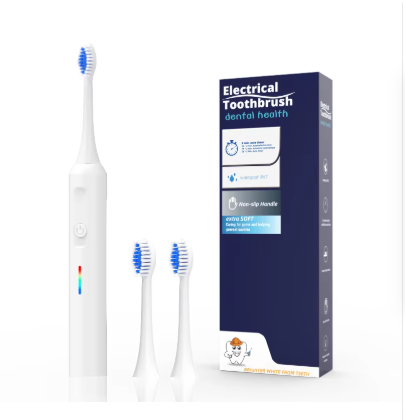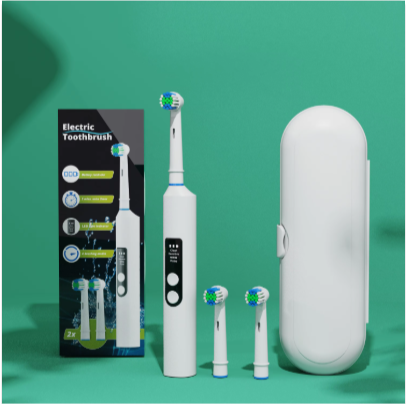Using Electric Toothbrushes with Orthodontic Appliances
The journey of wearing braces comes with unique oral hygiene challenges, and many orthodontic patients wonder about the best tools for maintaining their dental health. Electric toothbrushes have revolutionized oral care, but their safety and effectiveness for braces wearers deserve careful consideration. Modern electric toothbrushes actually offer several advantages for people with orthodontic appliances, making them an excellent choice when used correctly.
Understanding how to properly maintain oral hygiene while wearing braces is crucial for achieving optimal treatment results. Electric toothbrushes can play a vital role in this process, offering enhanced cleaning capabilities that can reach areas traditional manual brushes might miss. This comprehensive guide will explore the relationship between electric toothbrushes and braces, helping you make informed decisions about your oral care routine.

Benefits of Electric Toothbrushes for Braces
Enhanced Cleaning Power Around Brackets
Electric toothbrushes provide superior cleaning action through their oscillating or sonic technology. The powered movements help dislodge food particles and plaque from around brackets and wires more effectively than manual brushing alone. The precision of electric toothbrushes allows them to clean both above and below the orthodontic wire, reaching areas that often accumulate debris.
The consistent motion of electric toothbrushes ensures that each tooth receives thorough attention, reducing the risk of decay and staining during orthodontic treatment. This mechanical advantage becomes particularly valuable when dealing with the complex surfaces created by braces components.
Time-Saving and Efficient Cleaning
Maintaining proper oral hygiene with braces typically requires more time and effort than usual. Electric toothbrushes can significantly reduce the time needed for effective cleaning while maintaining superior results. Built-in timers help ensure that users spend adequate time cleaning each quadrant of their mouth, promoting thorough and systematic brushing habits.
The efficient cleaning action of electric toothbrushes can cut down brushing time while achieving better results compared to manual brushing. This efficiency is particularly beneficial for younger braces wearers or those with busy schedules who might otherwise rush through their oral care routine.
Selecting the Right Electric Toothbrush Model
Features to Consider for Orthodontic Care
When choosing an electric toothbrush for use with braces, certain features deserve special attention. Look for models with pressure sensors that alert users when they're brushing too hard, preventing damage to both the braces and gums. Specialized brush heads designed for orthodontic appliances can make a significant difference in cleaning effectiveness.
Multiple speed settings allow users to adjust the intensity based on their comfort level and specific cleaning needs. Some advanced models even offer smartphone connectivity and tracking features to help monitor brushing habits and technique.
Recommended Brush Head Types
Orthodontic brush heads are specifically designed with V-shaped bristle patterns that clean effectively around brackets and wires. Soft bristles are essential to prevent irritation while maintaining gentle yet thorough cleaning action. Consider brush heads with varying bristle lengths that can better access different areas around orthodontic appliances.
Regular replacement of brush heads becomes even more critical when wearing braces, as bristles wear down faster due to contact with metal components. Most manufacturers recommend changing brush heads every three months, but braces wearers might need more frequent replacements.
Proper Technique and Maintenance
Optimal Brushing Methods with Braces
Developing proper brushing technique with an electric toothbrush while wearing braces requires attention to detail. Hold the brush at a 45-degree angle to clean above and below the brackets, allowing the bristles to do the work without applying excessive pressure. Pay special attention to the areas where the brackets meet the tooth surface.
Systematic cleaning ensures no areas are missed during brushing. Start with the outer surfaces, then move to the inner surfaces, and finally clean the chewing surfaces of teeth. Take extra time around elastic bands and other orthodontic accessories where food particles commonly accumulate.
Care and Cleaning of Your Device
Maintaining your electric toothbrush in optimal condition ensures its effectiveness and longevity. Clean the brush head thoroughly after each use, removing any debris or toothpaste residue. Regular sanitizing of the brush head can prevent bacterial growth and maintain hygiene standards.
Keep the charging base clean and dry, and store the toothbrush in an upright position to allow proper drainage. Check the battery life regularly to ensure consistent performance, as reduced power can affect cleaning effectiveness.
Common Concerns and Solutions
Addressing Sensitivity Issues
Some braces wearers may experience increased sensitivity when first using an electric toothbrush. Start with the lowest speed setting and gradually increase as comfort levels improve. Using sensitive toothpaste can help minimize discomfort while maintaining effective cleaning.
If sensitivity persists, consult your orthodontist for personalized advice. They may recommend specific techniques or products to help manage sensitivity while maintaining optimal oral hygiene.
Preventing Damage to Orthodontic Hardware
While electric toothbrushes are safe for braces, proper usage is essential to prevent damage to orthodontic appliances. Avoid applying excessive pressure, and let the brush's mechanical action do the work. Pay attention to any unusual sounds or sensations that might indicate contact between the brush and metal components.
Regular check-ups with your orthodontist can help ensure your brushing technique isn't causing any unintended wear or damage to your braces. They can provide feedback and adjustments to your cleaning routine as needed.
Frequently Asked Questions
How often should I brush my teeth with an electric toothbrush while wearing braces?
Brush at least twice daily, though ideally after every meal when wearing braces. Each brushing session should last a minimum of two minutes, with extra attention given to areas around brackets and wires.
Can electric toothbrushes damage or loosen my braces?
When used properly, electric toothbrushes won't damage or loosen braces. Use gentle pressure and the correct technique, allowing the brush's mechanical action to do the cleaning work rather than applying force.
Should I still use other cleaning tools alongside my electric toothbrush?
Yes, complement your electric toothbrush with other recommended tools such as floss threaders, interdental brushes, and water flossers for comprehensive oral care while wearing braces. Your orthodontist can provide specific recommendations based on your needs.


